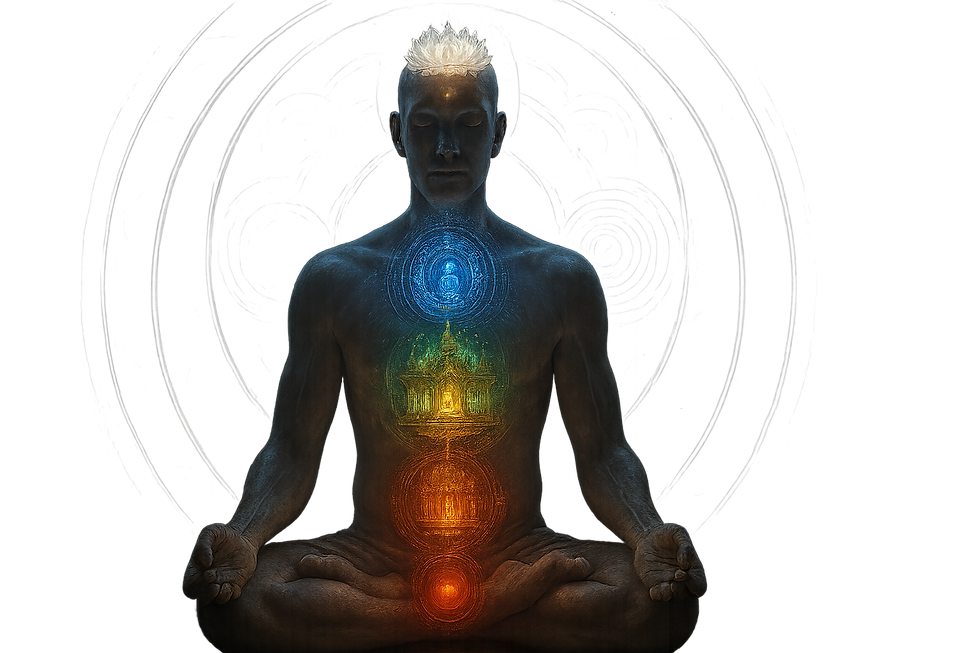The Divine Anatomy: How Tibetan Buddhism Maps Deities Within the Human Body
- Wake BreatheLove
- Aug 23
- 3 min read

The Sacred Body as a Temple
In Tibetan Buddhism, the body is never regarded as a mere shell of flesh and bone. Instead, it is viewed as a living mandala—an inner cosmos that mirrors the vastness of the external universe. Just as temples are adorned with sacred images of Buddhas and Bodhisattvas, the subtle body is said to be naturally inhabited by luminous deities. These are not external gods, but expressions of enlightened qualities within our own being.
The great yogis of Tibet teach that when one looks inward with clarity, the body reveals itself as a palace of wisdom, compassion, and radiant energies. This is the beginning of what we may call divine anatomy—a spiritual cartography of deities mapped within the channels, chakras, and energies of the human form.

The Subtle Body: Channels, Winds, and Drops
Before we can understand the presence of deities within, we must first look at the subtle body system as described in Vajrayana.
Channels (tsa): Energy pathways, similar to rivers, flowing through the body.
Winds (lung, prana): Vital energies that move through these channels, carrying both life force and states of consciousness.
Drops (tigle): Subtle essences stored within the chakras, radiant like pearls of light.
These three form the landscape upon which visualization and deity practice unfold. Just as the physical body has a skeleton and nervous system, the subtle body provides the infrastructure for meditation and transformation.

Mapping the Deities: Chakras as Palaces
In tantric practice, each chakra is visualized as a palace housing deities. These deities are not “inhabitants” in a literal sense, but personifications of enlightened energies.
Crown Chakra (Sahasrara) → A seat of supreme wisdom, often visualized as the abode of the central Buddha family, such as Vairocana, the Buddha of the central mandala.
Throat Chakra → Associated with sound, mantra, and the presence of Amitabha or other Buddhas of speech.
Heart Chakra → Considered the most sacred, the dwelling of one’s innermost Buddha-nature, often visualized as a tiny deity or flame of awareness.
Navel Chakra → A powerhouse of energy, sometimes connected to tantric deities who represent transformative fire, such as Chakrasamvara.
Secret Chakra (below navel) → The seat of bliss-essence, where wisdom and method unite in tantric yoga.
Through visualization, practitioners learn to “see” each part of their body as a holy sanctuary, filled with enlightened presence.
Inner Mandala: Microcosm and Macrocosm
The genius of this system lies in how the inner body mirrors the outer cosmos. Tibetan Buddhism sees the human form as a microcosm of the entire mandala of existence:
The five Buddha families correspond to five chakras.
The elements (earth, water, fire, air, space) correspond to bodily systems and organs.
The outer universe of mountains, rivers, and stars has its reflection in the inner channels and winds.
This mapping transforms meditation into a journey where the practitioner realizes that nothing is outside—the vast cosmos and the innermost body are expressions of the same reality.

Deity Yoga: Inviting and Dissolving the Divine
At the heart of tantric practice is deity yoga, where practitioners visualize themselves as a deity and their body as a palace of light. Advanced stages involve:
Generation Stage → Building the visualization of deities within the chakras, each glowing like a jewel in a palace.
Completion Stage → Dissolving the visualization into radiant emptiness, recognizing that the deity was never separate from one’s true mind.
This union of form and emptiness leads the meditator to a direct recognition of the enlightened nature of body, speech, and mind.
Advanced Understanding: Beyond Form, Into Emptiness
While beginners may see the body as inhabited by many deities, advanced teachings reveal a deeper truth: all deities are the play of mind itself.
The deities are archetypal expressions of awakened qualities—compassion, wisdom, fearlessness—already present within.
The body, when fully realized, is experienced as a Buddha-field (kṣetra)—a pure land in microcosm.
Ultimately, divine anatomy is not about adding deities into the body, but recognizing that the body itself is deity, the mind itself is Dharmakaya.
Thus, Tibetan Buddhism leads us from outer imagery to inner recognition, and finally to the non-dual experience where self and deity, body and cosmos, form and emptiness are one.

Conclusion: The Living Mandala of You
To see the body as divine anatomy is to transform ordinary perception into sacred vision. Instead of bones and blood, we see palaces and deities. Instead of a self-centered organism, we experience a mandala of awakened qualities.
This is not metaphor, but a practical technology of awakening that Tibetan masters have refined for centuries. By meditating on the deities within the body, we learn to recognize that the divine was never outside—it was always here, pulsing through our channels, radiating from our heart, breathing with each wind of life.
In the end, the greatest secret of divine anatomy is simple yet profound: you are already a living temple of enlightenment.
.png)



Comments